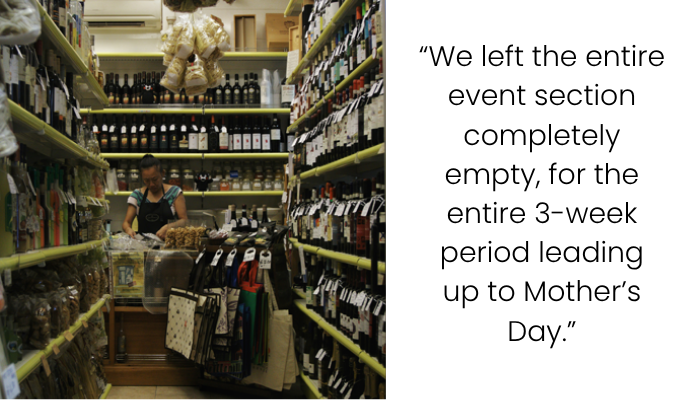“Just Leave It Empty”: When Corporate Logic Defeats Common Sense
In this tale of corporate miscommunication and the unintended consequences of rigid top-down policies, a retail employee recounts a comically frustrating experience with upper management’s inflexible instructions. The narrator worked at a mid-sized store that regularly rotated themed “event” shelves for holidays and seasonal promotions. These displays were critical for capturing customer attention and boosting sales during specific times of the year. However, a perplexing directive from upper management disrupted this finely tuned system: if any promotional products were missing, staff were explicitly told not to substitute or fill the empty spaces.
This policy might have worked in theory but quickly unraveled in practice. Just before Mother’s Day—one of the most significant retail events of the spring season—an entire shipment of promotional stock failed to arrive. When staff followed the baffling order to leave the display empty, it resulted in three weeks of empty shelves during peak foot traffic. Predictably, sales plummeted. Yet upper management, seemingly oblivious, was stunned to learn of the dismal performance and initially blamed the local staff. Only after being reminded of their own directives did they awkwardly pivot, ultimately reversing their stance with a sheepish admission of error.
“Jam-packed” is how many of us would like to find shelves when doing our holiday shopping

But customers were greeted with empty space and air at one store, after staff followed management’s instructions with precision











Policy Pitfalls and the Cost of Top-Down Mismanagement
This story highlights a classic retail operations failure, rooted in the pitfalls of centralized decision-making without field-level feedback loops. Retail chains often rely on uniform policies for consistency, but rigid mandates can quickly become liabilities when applied without context. The directive to leave shelves empty to “simulate sell-outs” might have been based on psychological sales tactics—creating the illusion of high demand can, in some scenarios, drive urgency and purchases. However, this only works when there’s actually a scarcity of desirable products, not when nothing is there at all.
Studies in consumer behavior have shown that perceived scarcity can boost purchase intent (Lynn, 1991), but only when customers believe the item was popular—not absent. An empty display without any trace of associated products leads to confusion, not demand. Furthermore, from a visual merchandising standpoint, empty shelf space is often seen as mismanagement or poor planning, which can degrade customer trust and brand perception (Levy et al., “Retailing Management”).

This case also reflects a failure in the supply chain communication cycle. If store-level staff had the autonomy to adapt in real-time—as they had in the past—sales losses could have been mitigated. In retail management literature, decentralized decision-making and empowered employees are frequently cited as effective buffers against supply chain disruptions (Simchi-Levi et al., “Designing and Managing the Supply Chain”). The final reversal by upper management underscores a recognition—albeit late—that rigid hierarchies and inflexible policies can cause more harm than good.
Ultimately, this incident serves as a cautionary tale: empowering local teams with discretion, especially in dynamic retail environments, often leads to better customer experiences and improved financial outcomes.
The store worker provided some more info in the comments







